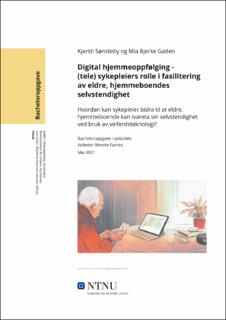| dc.contributor.advisor | Furnes, Merete. | |
| dc.contributor.author | Sønsteby, Kjersti. | |
| dc.contributor.author | Gaden, Mia Bjerke. | |
| dc.date.accessioned | 2021-09-24T19:51:59Z | |
| dc.date.available | 2021-09-24T19:51:59Z | |
| dc.date.issued | 2021 | |
| dc.identifier | no.ntnu:inspera:77258684:81467753 | |
| dc.identifier.uri | https://hdl.handle.net/11250/2782373 | |
| dc.description.abstract | Bakgrunn: Den eldre befolkningen øker, og i fremtiden vil det foreligge en ubalanse mellom tilbud og etterspørsel av helsetjenester (Jf. Eldrebølgen). Velferdsteknologi kan anes som et viktig og nødvendig element for å møte disse samfunnsutfordringene. Digital hjemmeoppfølging en en type velferdsteknologi, som bidrar til at eldre, hjemmeboende kan kommunisere med helsepersonell og overvåke egen sykdom i hjemmet, slik at de kan leve et mer selvstendig liv.
Hensikt: Oppgavens hensikt er å belyse hvordan sykepleier kan ta i bruk digital avstandsoppfølging på en hensiktsmessig måte til det beste for både pasienten, pårørende, samt de som som utfører helse – og omsorgstjenestene. Dette for å styrke pasienten og brukerens selvstendighet slik at de kan bo hjemme lengre.
Metode: Det ble gjennomført en litteraturstudie ved bruk av sju vitenskapelige artikler, hvor resultatene er analysert ved hjelp av en tematisk analyse. De sju artiklene inneholdt både kvalitative og kvantitative metoder, samt kombinerte metoder. Artiklene ble funnet ved hjelp av systematiske søk i anerkjente, helsefaglige databaser, ved bruk av søkeord som «Telehealth», «Telemedicine», «Telemonitoring», «Telenursing», «Telecare», «Self-Management», «Self-Care», «Independent Living», «Aged» m.fl.
Resultat: Den tematiske analysen avdekket seks tema: «Sykepleier som teknologifasilitator», «Individuelle målsettinger», «Brukervennlighet», «Empowerment», «Systematisk samarbeid» og «Digital kontakt versus fysisk tilstedeværelse»
Konklusjon: For å sikre at de eldre, hjemmeboende kan ivareta sin selvstendighet, så bør sykepleier inneha en positiv holdning til teknologi generelt, samt god kommunikasjon – og relasjonkompetanse. Sykepleier må formidle potensialet som finnes i teknologien, og ivareta brukermedvirkningen. Sykepleier må også involvere pasientene tidlig i indviduell planutvikling og målformulering gjennom et gjensidig samarbeid. Teknologien må tilpasses hver enkelt pasient, og den må være relativ enkel å ta i bruk. Brukeropplæring er viktig, samt å involvere pårørende og annet helsepersonell. Sykepleier bør også sørge for at teknologien blir et supplement, og at det foreligger en balanse mellom digital kontakt og fysisk tilstedeværelse. | |
| dc.description.abstract | Background: The elderly population is increasing, and in the future there will be an imbalance between supply and demand for health services. Welfare technology can be seen as an important and necessary element in meeting these societal challenges. Telemonitoring is a type of welfare technology, which helps older people living at home to communicate with health professionals and monitor their own illness at home, so that they can live a more independent life.
Purpose: The bachelor thesis` purpose is to highlight how the nurse can use telemonitoring in an appropriate way for the benefit of both the patient, next of kin, as well as the people who perform health care services. This is to strengthen the patient and the user's independence so that they can live at home for a longer time.
Methods: A literature study was conducted using seven scientific articles, where the results are analyzed using a thematic analysis. The seven articles contained both qualitative and quantitative methods, as well as combined methods.
The articles were found by the use of systematic searches in reputable, health professional databases, using keywords such as «Telehealth», «Telemedicine», «Telemonitoring», «Telenursing», «Telecare», «Self-Management», «Self-Care», «Independent Living», «Aged», among others.
Results: The thematic analysis revealed six themes: «Nurse as a technology facilitator», «Individual objectives», «Ease of use», «Empowerment», «Systematic collaboration» and «Digital contact versus physical presence»
Conclusion: To ensure that the elderly, those living at home can maintain their independence, the nurse should have a positive attitude towards technology in general, as well as good communication and relationship skills. The nurse must convey the potential that exists in the technology, and focus on user participation. Nurses must also involve patients early in individual plan development and goal formulation through a mutual collaboration. The technology must be adapted to each individual patient, and it must be relatively easy to use. User training is important, as well as involving next of kin and other health personnel. The nurse should also ensure that the technology is a supplement, and that there is a balance between digital contact and physical presence. | |
| dc.language | nob | |
| dc.publisher | NTNU | |
| dc.title | «Digital hjemmeoppfølging – (tele) sykepleiers rolle i fasilitering
av eldre hjemmeboendes selvstendighet» | |
| dc.type | Bachelor thesis | |
